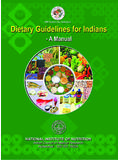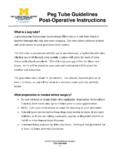Transcription of Guidelines for the inpatient severely malnourished
1 Guidelines for the inpatient treatment of severely malnourished children1 Guidelinesfor theinpatienttreatment ofseverelymalnourishedchildrenAuthors1 Ann AshworthSultana KhanumAlan JacksonClaire Schofield1Dr Sultana Khanum, former Regional Adviser, Nutrition for Health and Development, WHO South-East Asia Regional OfficeProfessor Ann Ashworth & Ms Claire Schofield, London School of Hygiene and Tropical MedicineProfessor Alan Jackson, University of SouthamptonGuidelines for the inpatient treatment of severely malnourished children2 WHO Library Cataloguing-in-Publication DataAshworth, for the inpatient treatment of severely malnourished children /Ann Ashworth .. [et al.]1. Child nutrition disorders therapy 2. Starvation therapy 3. 4. Manuals ISBN 92 4 154609 3 (NLM classification: WS 115) World Health Organization 2003 All rights reserved. Publications of the World Health Organization can beobtained from Marketing and Dissemination, World Health Organization, 20 Avenue Appia, 1211 Geneva 27, Switzerland (tel: +41 22 791 2476; fax: +4122 791 4857; email: Requests for permission toreproduce or translate WHO publications whether for sale or fornoncommercial distribution should be addressed to Publications, at theabove address (fax: +41 22 791 4806; email: designations employed and the presentation of the material in thispublication do not imply the expression of any opinion whatsoever on thepart of the World Health Organization concerning the legal status of anycountry, territory, city or area or of its authorities, or concerning thedelimitation of its frontiers or boundaries.))
2 Dotted lines on maps representapproximate border lines for which there may not yet be full mention of specific companies or of certain manufacturers productsdoes not imply that they are endorsed or recommended by the World HealthOrganization in preference to others of a similar nature that are notmentioned. Errors and omissions excepted, the names of proprietaryproducts are distinguished by initial capital World Health Organization does not warrant that the informationcontained in this publication is complete and correct and shall not be liablefor any damages incurred as a result of its inGuidelines for the inpatient treatment of severely malnourished children3 PrefaceAcknowledgementsIntroductionA. General principles for routine care (the 10 Steps )10 Step hypoglycaemia11 Step hypothermia11 Step dehydration12 Step electrolyte imbalance14 Step infection14 Step micronutrient deficiencies16 Step cautious feeding16 Step catch-up growth18 Step sensory stimulation and emotional support19 Step for follow-up after recovery20B.
3 Emergency treatment of shock and severe anaemia211. Shock in severely malnourished children212. Severe anaemia in malnourished children22C. Treatment of associated conditions231. Vitamin A deficiency232. Dermatosis233. Parasitic worms244. Continuing diarrhoea245. Tuberculosis (TB)24D. Failure to respond to treatment251. High mortality252. Low weight gain during the rehabilitation phase25E. Discharge before recovery is complete28 Appendix reference table30 Appendix records32 Appendix 3. Recipes for ReSoMal & electrolyte/mineral solution 33 Appendix reference table35 Appendix for starter and catch-up formulas38 Appendix 6. Volume of F-75 to give for children of differentweights40 Appendix 7. Volume of F-75 for children with severe (+++)oedema41 Appendix of volumes for free feeding with F-10042 Appendix record chart43 Appendix play activities44 Appendix card47 ContentsGuidelines for the inpatient treatment of severely malnourished children4 Guidelines for the inpatient treatment of severely malnourished children5 PrefacePoor nutrition severely hinders personal, social and national problem is more obvious among the poor and disadvantaged.
4 Theultimate consequence is millions of severely malnourished children throughoutthe world. In developing countries an estimated million children underthe age of five are malnourished , and those who are severely malnourishedand admitted to hospital face a 30-50% case fatality rate. With appropriatetreatment, as described in these Guidelines , this unacceptably high deathrate can be reduced to less than 5%. The evidence base for effectiveprevention and treatment is incontrovertible, but it is not put into from 67 studies worldwide show that the median case fatality ratehas not changed for the past five decades, and that one in four severelymalnourished children died during treatment in the 1990s. In any decade,however, some centres obtained good results with fewer than 5% dying,whereas others fared poorly with a mortality rate of approximately 50%.This disparity is not due to differences in the prevalence of severe cases ofmalnutrition, but it is rather the result of poor treatment practices.
5 Where mortalityis low a set of basic principles has been followed. High case fatality ratesand poor rates of weight gain result from a failure to appreciate that treatmenthas to be carried out in stages and that the order in which problems areaddressed is fundamental to effective care: firstly, severe malnutrition represents a medical emergency with anurgent need to correct hypothermia, hypoglycaemia and silent infection; secondly, there is an impairment of the cellular machinery. Tissuefunction cannot be restored unless the machinery is repaired, whichincludes remedying multiple specific deficiencies. These may not bevisible, and often are the consequence of multiple silent infections; thirdly, tissue deficits and abnormal body composition are obvious,but cannot be safely corrected until the cellular machinery has beenadequately repaired. Rehydration with intravenous fluids can increasemortality, as can manipulation of abnormal blood attempts to promote rapid weight gain from the start oftreatment is also dangerous.
6 Many prescribe a high protein diet forchildren with kwashiorkor, but this can be fatal. Many prescribediuretics to get rid of oedema. This procedure can be fatal. Prescribingiron to treat anaemia increases deaths in the initial phase of for the inpatient treatment of severely malnourished children6 Substantial reductions in mortality rates have been achieved by modifyingtreatment to take account of the physiological and metabolic changesoccurring in severe malnutrition. In the International Centre for DiarrhoealDisease Research, Bangladesh, after the introduction of a standardizedprotocol, based on the WHO Guidelines , fatality rate decreased to 9% andsubsequently to from an earlier 17%. In South Africa, the mortality ratedecreased from 30-40% to less than 15%. Emergency relief organizationssuccessfully use the Guidelines to treat severe malnutrition in Guidelines described here are therefore applicable not only inhospitals but also in therapeutic feeding centres in emergency situations,and in nutrition rehabilitation centres after initial treatment in KhanumDepartment of Nutrition for Health and Development World HealthOrganizationGuidelines for the inpatient treatment of severely malnourished children7 AcknowledgementsThe authors gratefully acknowledge the contributions and suggestions of DrGraeme Clugston, Dr Djamil Benbouzid, and Dr Olivier Fontaine (WHOG eneva), and Professor Michael Golden (University of Aberdeen).
7 Thanks are due to Professor Sally Grantham-McGregor (Institute of ChildHealth) for the play activities, and to Professor John Waterlow, ProfessorJoe Millward, Dr Harry Campbell, Ann Burgess and Patricia Whitesell fortheir advice and addition, WHO wishes to thank the Canadian International DevelopmentAgency (CIDA) and the Department for International Development (DFID), , for providing financial support for the production of this for the inpatient treatment of severely malnourished children8 Guidelines for the inpatient treatment of severely malnourished children9 IntroductionEvery year some million children die before they reach their fifthbirthday. Seven out of every 10 of these deaths are due to diarrhoea,pneumonia, measles, malaria or malnutrition. The WHO manualManagement of Severe Malnutrition: a manual for physicians and othersenior health workers and the following companion Guidelines have beendeveloped to improve inpatient treatment of severe malnutrition.
8 The WHO/UNICEF strategy of Integrated Management of Childhood Illness (IMCI)also aims to reduce these deaths by improving Guidelines are needed because of the profound physiological andmetabolic changes that take place when children become changes affect every cell, organ and system. The process of changeis called reductive adaptation. malnourished children do not respond to medicaltreatment in the same way as if they were well nourished. Malnourishedchildren are much more likely to die, with or without complications, than theirwell nourished counterparts. With appropriate case management in hospitaland follow-up care, the lives of many children can be following Guidelines set out simple, specific instructions for thetreatment of severely malnourished children. The aim is to provide practicalhelp for those responsible for the medical and dietary management of suchchildren. Lack of appropriate care leads to diarrhoea, poor appetite, slowrecovery and high mortality.
9 These problems can be overcome if certainbasic principles are malnutrition is defined in these Guidelines as the presence ofsevere wasting (<70% weight-for-height or <-3SD) and/or oedema.(Appendix 1 provides a weight-for-height reference table.)The Guidelines are divided in five principles for routine care (the 10 steps ) treatment of shock and severe of associated to respond to before recovery is completeGuidelines for the inpatient treatment of severely malnourished children10A. GENERAL PRINCIPLES FOR ROUTINE CARE(the 10 Steps )2 There are ten essential steps: 1. Treat/prevent hypoglycaemia 2. Treat/prevent hypothermia 3. Treat/prevent dehydration 4. Correct electrolyte imbalance 5. Treat/prevent infection 6. Correct micronutrient deficiencies 7. Start cautious feeding 8. Achieve catch-up growth 9. Provide sensory stimulation and emotional support10. Prepare for follow-up after recoveryThese steps are accomplished in two phases: an initial stabilisation phasewhere the acute medical conditions are managed; and a longer rehabilitationphase.
10 Note that treatment procedures are similar for marasmus andkwashiorkor. The approximate time-scale is given in the box below:PHASESTABILISATIONREHABILITATIONSt epDays 1-2 Days 3-7 Weeks 2-61. Hypoglycaemia2. Hypothermia3. Dehydration4. Electrolytes5. Infection6. Micronutrients7. Cautious feeding8. Catch-up growth9. Sensory stimulation10. Prepare for follow-up2 Ashworth A, Jackson A, Khanum S, Schofield C. Ten steps to recovery: Child health dialogue,issue 3 and 4, 1996no ironwith ironGuidelines for the inpatient treatment of severely malnourished children11 Step 1. Treat/prevent hypoglycaemiaHypoglycaemia and hypothermia usually occur together and are signs ofinfection. Check for hypoglycaemia whenever hypothermia(axillary< ; rectal< ) is found. Frequent feeding is important inpreventing both :If the child is conscious and dextrostix shows <3mmol/l or 54mg/dl give: 50 ml bolus of 10% glucose or 10% sucrose solution (1 roundedteaspoon of sugar in tablespoons water), orally or by nasogastric(NG) tube.
















